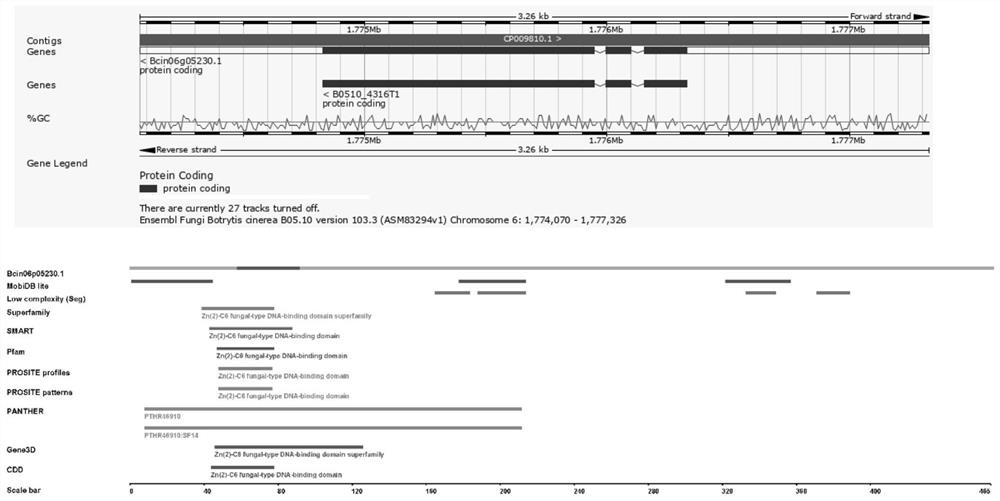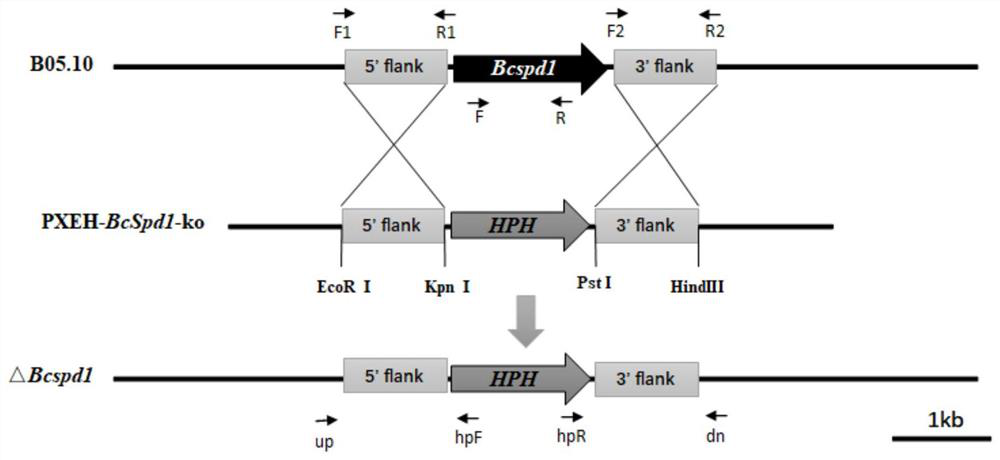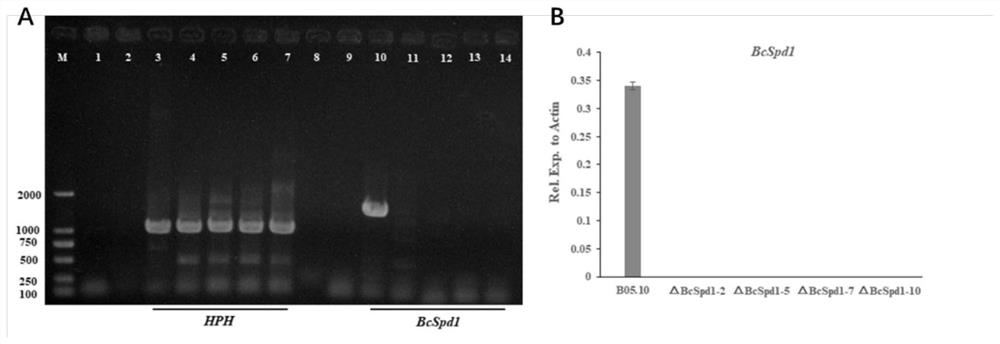Application of BcSpd1 gene in prevention and treatment of plant gray mold and improvement of disease resistance
A technology of plant ash and cinerea, applied in the field of microbial genetic engineering, can solve problems such as unclear functions of melanin
- Summary
- Abstract
- Description
- Claims
- Application Information
AI Technical Summary
Problems solved by technology
Method used
Image
Examples
Embodiment 1
[0051] Example 1. Correlation analysis of BcSpd1 gene
[0052] The open reading frame of the BcSpd1 gene of Botrytis cinerea consists of 1504 nucleotides, including 3 exons, and the total length of the coding region is 1398 nucleotides. The encoded protein product consists of 465 amino acids. Prediction analysis of BcSpd1 gene in Botrytis cinerea genome website (http: / / fungi.ensembl.org / Botrytis_cinerea / Location / View?r=6:1774070-1777326; g=BCIN06G05230; db=core), BcSpd1 gene number BCIN06G05230, this gene has a conserved Zn 2 C 6 domain, which belongs to typical zinc cluster proteins (such as figure 1 shown).
Embodiment 2
[0053] Example 2. Knockout and genetic complementation of BcSpd1 gene
[0054] 1) Knockout vector construction
[0055] Primers were designed by DNAMAN and synthesized by Shanghai Sangon Biotechnology Co., Ltd., using primers BcSpd1-UP-F (5'-GGCGGCCTCGAGAGTCTAACCCTCAAGAGCCAG-3') and BcSpd1-UP-R (5'-ATGAGCTCGAATTGGAGTTCCAAGTTGAGTGAT-3'), The upstream 998 fragment of BcSpd1 gene was amplified using the genomic DNA of Botrytis cinerea strain B05.10; primers BcSpd1-DN-F (5'-GCTCTAGAGCCTCTTTTCAAGGCAGAACGGT-3') and BcSpd1-DN-R (5'-AACTGCAGTATCAACGCGAGCGCGAGCACT-3 '), using the genomic DNA of Botrytis cinerea strain B05.10 as a template to amplify the downstream 995bp fragment of the BcSpd1 gene. Reaction system (25 μL): Takara Primer STARMax DNA Polymerase (2×) 12.5 μL; upstream and downstream primers (10 μM) 1 μL each; template DNA 1 μL; ddH 2 O 9.5 μL. Amplification procedure: (1) 98°C for 10s; (2) 53°C for 15s; (3) 72°C for 10s to cycle 1-3 steps 35 times. The PCR products we...
Embodiment 3
[0065] Example 3. The role of BcSpd1 gene in the growth and development of Botrytis cinerea
[0066] B05.10, △BcSpd1, and △BcSpd1-C were stored at -80°C for activation on PDA medium, and after culturing upside down in a 25°C incubator for 2 days, a 6 mm uniform bacterial cake was punched out using a hole punch and inoculated. On a new PDA plate, the incubator was inverted at 25°C, and the colony diameter was measured every 12h and recorded by photographing. The results showed that the mycelial growth rate of △BcSpd1 was lower than that of the wild-type and apoplexy, and the difference became more and more obvious with the prolongation of time. At the 72nd hour, the average diameters of the wild-type and apoplexy colonies were 7.21 cm and 7.26 cm, respectively. The knockout body is only 5.94 cm, indicating that the growth rate of △BcSpd1 is slower than that of B05.10 (eg Figure 4 shown). It was shown that in wild-type strains, BcSpd1 positively regulates hyphal growth, and t...
PUM
 Login to View More
Login to View More Abstract
Description
Claims
Application Information
 Login to View More
Login to View More - R&D
- Intellectual Property
- Life Sciences
- Materials
- Tech Scout
- Unparalleled Data Quality
- Higher Quality Content
- 60% Fewer Hallucinations
Browse by: Latest US Patents, China's latest patents, Technical Efficacy Thesaurus, Application Domain, Technology Topic, Popular Technical Reports.
© 2025 PatSnap. All rights reserved.Legal|Privacy policy|Modern Slavery Act Transparency Statement|Sitemap|About US| Contact US: help@patsnap.com



